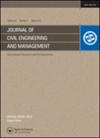标准侵彻试验修正对不排水抗剪强度估算的影响
IF 3.7
3区 工程技术
Q1 ENGINEERING, CIVIL
引用次数: 0
摘要
本文评估了标准贯入试验(SPT)修正系数,即锤击能量效率、钻孔直径、钻杆长度和取样方法,对SPT阻力(SPT-N)和不排水抗剪强度(Su)之间的相关性的影响。对从马来西亚槟城岛收集的土壤数据中得出的新方程(有SPT校正和无SPT校正)进行了比较。决定系数、绝对平均相对误差、标准差和方差分析(ANOVA)被用作评估的基础。最后,对未修正比率(Su/N)或修正比率(Su/N60)与塑性指数(PI)/流动性指数(LI)之间的关系进行了综合分析。根据结果,所有校正因素都对估计的Su产生了显著影响,因为ANOVA计算表明,钻孔直径校正在统计上最为显著。此外,随着PI和LI的增加,Su/N和Su/N60呈现出增加的趋势,这可能归因于土壤的状态和行为。此外,三次回归是关联参数的最佳拟合方程。总之,本研究为修正因子的影响提供了新的见解,可用于提高经验相关性和工程设计的准确性。本文章由计算机程序翻译,如有差异,请以英文原文为准。
EFFECT OF STANDARD PENETRATION TEST CORRECTIONS ON THE ESTIMATION OF UNDRAINED SHEAR STRENGTH
This paper evaluated the influence of Standard Penetration Test (SPT) correction factors, namely the hammer energy efficiency, borehole diameter, drill rod length, and sampling method, on the correlations between SPT resistance (SPT-N) and undrained shear strength (Su). Comparisons were made between new equations (with and without SPT corrections), which were derived from soil data collected from Penang Island, Malaysia. The coefficient of determination, Absolute Average Relative Error, Standard Deviation, and Analysis of Variance (ANOVA) were employed as the basis for the assessments. Finally, a comprehensive analysis was carried out to evaluate the relationship between uncorrected ratio (Su/N) or corrected ratio (Su/N60) and Plasticity Index (PI)/Liquidity Index (LI). Based on the results, all correction factors recorded a significant impact on the estimated Su, as the ANOVA calculation suggested that the borehole diameter correction was the most statistically significant. Furthermore, the Su/N and Su/N60 exhibited increasing trends with increased PI and LI, which may be attributed to the soil’s state and behaviour. Additionally, cubic regression is the best-fit equation to correlate the parameters. In summary, this study provided new insights into the influence of correction factors, which can be used to improve the accuracy of the empirical correlations and engineering designs.
求助全文
通过发布文献求助,成功后即可免费获取论文全文。
去求助
来源期刊

Journal of Civil Engineering and Management
ENGINEERING, CIVIL-
CiteScore
6.70
自引率
4.70%
发文量
0
审稿时长
1.7 months
期刊介绍:
The Journal of Civil Engineering and Management is a peer-reviewed journal that provides an international forum for the dissemination of the latest original research, achievements and developments. We publish for researchers, designers, users and manufacturers in the different fields of civil engineering and management.
The journal publishes original articles that present new information and reviews. Our objective is to provide essential information and new ideas to help improve civil engineering competency, efficiency and productivity in world markets.
The Journal of Civil Engineering and Management publishes articles in the following fields:
building materials and structures,
structural mechanics and physics,
geotechnical engineering,
road and bridge engineering,
urban engineering and economy,
constructions technology, economy and management,
information technologies in construction,
fire protection, thermoinsulation and renovation of buildings,
labour safety in construction.
 求助内容:
求助内容: 应助结果提醒方式:
应助结果提醒方式:


